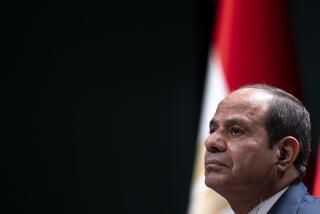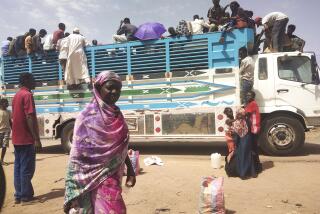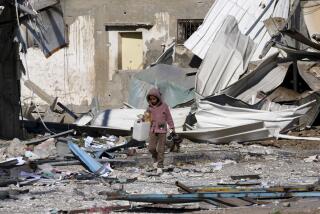U.S. Aid Generous and Stingy
WASHINGTON — Americans think of themselves as the most generous people on Earth. So to many, it came as a shock to hear that the U.S. response to the southern Asian tsunami this week was considered stingy.
But views of American generosity depend on who is doing the measuring and how.
By total money, the United States by far donates more than any other country in the world. This is the gauge preferred by most U.S. officials.
But when aid is calculated per U.S. citizen or as a percentage of the economy, the United States ranks among the least generous in the industrialized world.
As U.S. officials and foreign aid experts debate which measure is more apt, the issue is another example of how Americans’ views of themselves differ from those from around the world.
“I don’t take kindly to comments from the U.N. calling these miserly responses, when we’re the ones who generally foot the bill, and we will in this one,” said Sen. Sam Brownback (R-Kan.), referring to comments this week from U.N. aid officials questioning initial U.S. aid offers.
The Bush administration now is pledging much more, at least $35 million, up from $15 million, and said the amount would rise further. Still, others in Washington sympathize with the view held outside U.S. borders that Americans can afford more.
“It’s embarrassing,” said Tim Rieser, an aide to Sen. Patrick J. Leahy (D-Vt.) who works on foreign aid issues in the Senate and was in the Sri Lankan capital when the tsunami struck. “Nothing illustrates this more vividly than that out of a trillion-dollar budget, we provide less than 1% for foreign assistance and far less than 1% for humanitarian aid.
“Our ability to give far exceeds what we do give,” Rieser said.
Critics of U.S. giving often cite statistics from the Paris-based Organization of Economic Cooperation and Development, which each year measures overseas development assistance as a percentage of gross national income for the 22 leading industrialized nations.
In 2003, the United States ranked dead last on OECD’s list, spending only 0.15% of its national income. Other Western countries contributed more. Norway spent 0.92% of its national income; France 0.4% and Britain 0.34%.
Officials in both the Bush and the Clinton administrations have argued that the OECD statistics are misleading. The OECD does not measure many forms of assistance provided by the U.S. government other than formal foreign aid, officials said.
Although the OECD measure puts U.S. spending on foreign aid at $16.2 billion last year, the U.S. Agency for International Development counts U.S. giving differently. USAID officials point to its report on aid in 2000 saying government assistance to developing countries totaled $22.6 billion. Further, private assistance -- including giving by individuals, religious groups, foundations, corporations, universities and others -- was an additional $33.6 billion, said USAID, for a total of more than $56 billion.
Still, many outside the U.S. government believe that aid spending should not include some military expenditures or funds to promote democracy.
Even using the American view of largess, the United States comes up short compared with other nations, said Patrick Cronin, a former assistant administrator for policy and program coordination at USAID under President Bush.
“We have to do more,” said Cronin, now at the Center for Strategic and International Studies, a Washington think-tank. “But we have to do it smart, and we have to change the debate away from a simple redistribution of wealth to a discussion of ... aid effectiveness.”
A different key measure of international generosity was devised by the Center for Global Development and Foreign Policy magazine. It ranked rich countries’ contributions to the poor in terms of contributions through aid, trade, investment, technology, security, technology and the environment. Countries got points for the quality as well as the quantity of their aid and contributions.
On that scale, the U.S. ranked seventh out of 21 nations, behind Canada, Britain, Australia, Sweden, Denmark and the Netherlands.
Japan, which is one of the world’s largest aid donors but collects huge interest payments on its development loans, ranked last.
The scale found that U.S. contributions of pure foreign aid was relatively much lower than other countries’. The U.S. scored higher on immigration and trade. Allowing foreigners and foreign products into the country are considered measures of how much a rich country is willing to help poorer ones.
But the study upended the commonly held view that shortfalls in U.S. government aid for the global poor were made up by private American contributions.
It found that U.S. government foreign aid in 2002 worked out to 13 cents per American a day. Private donations from U.S. citizens amounted to 5 cents per person a day.
But in 16 other countries, governments gave more. And in three other countries -- Switzerland, Ireland and Norway -- private citizens gave more.
The Norwegian government gave $1.02 per citizen a day while private giving came to 24 cents a day.
Cronin said that U.S. per capita giving would never match that of Norway, a nation of 4.5 million. On the other hand, the United States makes many other contributions that are hard to quantify in dollar terms, he said, including using its military prowess for worldwide peacekeeping operations that benefit others, or airlifting tsunami relief supplies to remote areas and sending in ships that desalinate water.
“We’re not going to hand out the Nobel Peace Prize, but we are going to go into harm’s way and provide international security in a way Norway won’t, even though they are a staunch U.S. ally,” Cronin said.
David Roodman, one of the architects of the Center for Global Development study, argued that no wealthy country was giving enough to the poor.
“Stingy, of course, is a relative term,” Roodman said. “I wouldn’t say the entire world is stingy. But helping the rest of the world is clearly a low priority in making our policies, and that’s true in every country to a greater or lesser extent.”
U.S. overseas assistance aid declined in the late 1990s but has increased under Bush from $10 billion in 2000 to $16 billion in 2004. That represents about a quarter of total aid from all the industrialized countries.
At the same time, without another large spending hike, U.S. commitments to Iraq and Afghanistan and now the 11 tsunami-stricken nations are expected to strain the budget for aid to other parts of the world.
Some critics compared Bush’s $35-million pledge for the tsunami victims with the roughly $1 billion a week the U.S. was spending in Iraq.
Although the American left has traditionally lobbied for more foreign aid, it is the Christian right that is credited with convincing the administration to spend more on fighting global AIDS and on hunger in Africa. Christian groups also pressed Bush to increase relief efforts for the tsunami victims.
Given the war in Iraq, political efforts in the Muslim world are especially sensitive. Some critics have argued that the administration should have jumped at a chance to show its generosity over a natural disaster that hit Asian Muslims.
In an interview with ABC News’ “Nightline,” outgoing Secretary of State Colin L. Powell defended the administration’s efforts on behalf of Muslims. He said the U.S. had played an important role in Kosovo, Kuwait, Iraq and Afghanistan, where he maintained Muslim populations were freed from oppression.
“So we have nothing to apologize for with respect to what we have tried to do to help Muslims over the years,” Powell said. “And this [tsunami aid] is another example of our willingness to help.”
The Bush administration has tried to focus its aid on key goals such as economic and political reform. And its Millennium Challenge Account aid program is designed to give assistance to countries that use it most effectively toward those ends.
Some applaud those goals, saying Americans should insist on productive use of aid. Others, like David L. Phillips of the Council on Foreign Relations in New York, said the Bush administration “sees development assistance through an ideological prism.”
“Its approach to foreign aid is based on a democracy and freedom criteria,” Phillips said. “There’s nothing wrong with linking aid to democratic development, but that shouldn’t preclude countries that are just starting on the path to democracy from benefiting from foreign aid.”
Times staff writers Paul Richter and Peter Wallsten in Washington contributed to this report.
*
(BEGIN TEXT OF INFOBOX)
Foreign aid
Government aid and private giving, per person, per day in 2002:
*--* Country Government Private Norway $1.02 $0.24 Denmark 0.84 0.01 Sweden 0.61 0.01 Netherlands 0.57 0.04 Switzerland 0.35 0.07 Belgium 0.28 0.02 Ireland 0.28 0.06 France 0.25 0.01 Finland 0.24 0.01 Britain 0.23 0.02 Japan 0.20 0.004 Austria 0.18 0.02 Canada 0.17 0.02 Australia 0.14 0.03 United States 0.13 0.05 Italy 0.11 0.002 Spain 0.11 0.01 Portugal 0.9 0.001 New Zealand 0.8 0.01 Greece 0.7 0.001
*--*
Sources: Center for Global Development, Foreign Policy magazine
Los Angeles Times
More to Read
Sign up for Essential California
The most important California stories and recommendations in your inbox every morning.
You may occasionally receive promotional content from the Los Angeles Times.










